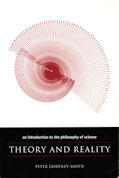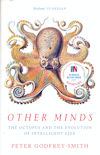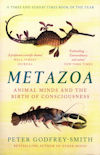The scuba-diving philosopher and bestselling author of
Other Minds is back, exploring the origins of animal consciousness.
Dip below the ocean’s surface with Peter Godfrey-Smith
and marvel at the appearance of the first animal body form
over half a billion years ago – a profound innovation that set life upon a new path.
Then follow the ways that evolutionary developments – eyes that track,
bodies that move through and manipulate the environment – shaped all animal life.
Exploring the evolutionary paths of a glass sponge, soft coral, banded shrimp, octopus and fish,
then moving onto land and the world of insects, birds and primates like ourselves,
Metazoa gathers these stories together to bridge the gap between matter and mind
and address one of the most important philosophical questions: what is the origin of consciousness?
Artificial Life, a discipline I work in, is the study of “life-as-it-could-be”, as opposed to “life-as-it-is”, the domain of Biology. But in order to push the borders of “is” into the lands of “could-be”, it is helpful to know where those borders are. As a non-biologist thinking of life on Earth, we might consider the animal kingdom – mammals, birds, fish – and we might remember that insects are animals, too, as are various other creepy-crawlies. We tend to be mostly animal-centric when we think of life, but we know there is also the plant kingdom: grass, flowers, trees, and other stuff. If pushed, we might recall that fungi are in their own kingdom, as are bacteria.
“Creepy-crawly” is the key term here: we tend to privilege life that moves under its own power. If we think of how it manages this, we tend to assume it has a few kinds of sensors (eyes, ears, touch, mostly) and actuators (legs, wings, fins, jaws) as part of a body controlled by some central brain. In his previous book, Other Minds , Godfrey-Smith demonstrates just how very parochial this view of animal life is. There he dives into the world of cephalopods (octopus, cuttlefish, and the like), and shows just how alien their world, and worldview, is to our experience. In this current book, Metazoa (that is, multi-celled animals), he broadens his view to the entire animal kingdom throughout evolution, demonstrating that the borders of life as-it-is, in all its grandeur of “endless forms most beautiful and most wonderful” , are wider than we may ever have dreamed.
Godfrey-Smith’s aim is to demonstrate how minds and subjectivity could have slowly arisen from the bottom up, evolving from the simplest early animals to the complex minds we see today. The key is a deeply materialistic, utterly non-dualistic, stance: minds are not the effect of complex physical processes in brains, they are those processes; those physical processes are not the causes of experiences, they are experiences. This view removes potential infinite regress: the processes are not the cause of some other thing that still needs to be explained, they are the actual thing, and hence the explanation. It also neatly shows why philosophical zombies, beings that have the physical processes but not the minds, are impossible: the processes are the minds. Godfrey-Smith elaborates this materialistic view throughout the book, explaining how, and why, the processes are as they are.
Starting small with single cells (so before metazoa themselves), he discusses how they need to extract order from the chaotic “molecular storm” of self-generated spontaneous activity. They use bio-electrical processes: a flow of ion currents, ion channels in membranes to control that flow, and feedback flows regulating the channels. Cells are necessarily open to their environment, inputting food (energy) and exporting waste (entropy). So once some complex feedback control process has been established, evolution can exploit it to take on other roles, such as a minimal form of sensing its environment. Then, such cells could themselves collaborate, say by forming a hollow cup or sphere, to trap food and useful chemicals, and to excrete further waste products, in a form of proto-gut. Then some of the food bacteria might evolve into symbiotic gut bacteria. So now there are three levels of structure – cell, gut, symbiosis – all controlled by a cobweb of bio-electrical signals. And then evolution can start co-opting this electrical cobweb into a nervous system: all cells are electrical; some exploit it for more complex signalling. There are further ways a creature uses its cellular electricity for communication and control, via the generated global dynamical electric field, which can both modulate and be modulated by neuronal and other cellular behaviours.
It’s not only electricity. Animals locomote by using muscles: a mechanical system that exploits cellular cytoskeletons to change their individual shapes, which, when properly coordinated, can cause mass motion. This ability to act (move), coupled with the ability to sense, leads to a new kind of agential creature. Agency, action “by-me”, controlled or directed by sensing, accompanies subjectivity, of being “for-me”, and a sense of “ownership” of the body, of being a “controlled whole”. Godfrey-Smith slowly builds up this picture, of more and more complex creatures and behaviours, showing how mind and consciousness, thoughts and memories, feelings and emotions, can slowly, gradually evolve, from ever more elaborations of this primitive embodied sensing/action/subjectivity loop. As a final step, higher minds can leap out of the system, from a straightforwardly subjective “being there” to a “being elsewhere”, of imagining other places, other possibilities, counterfactuals. This is all a continuum, with no “magic sauce” needed at any point.
This approach to subjectivity gives the first explanation of “qualia” that I have ever found in the least plausible (other than Dennett’s contention that the whole concept is a mistake, of course). It goes back to the original materialistic assertion, that the processes are the experience: “The qualia are not extra things that need an explanation, somehow produced by the workings of the physical system. Instead they are part of what it is to be the system being described.” [p.109]
Along the way, Godfrey-Smith covers a wildly diverse range of critters. There is a glass sponge: an animal with a glass skeleton through which light can be transmitted and filtered. It is not clear if the sponge exploits this capacity, but with the existence of bioluminescence in its environment, evolution may well have co-opted this for sensory, communication or other ends. Another species, cnidarians, has two adult forms that it may cycle between, a more complex lifestyle than mere uni-directional metamorphosis. He recaps the structure of the octopus brain: a 1+8 architecture with one sub-brain in each arm totalling more than the central brain in size. We, however, evolved from fish, a line with a relatively impoverished single brain architecture. For those fish still in the water, however, their entire body is a kind of giant pressure-sensitive ear.
This excellent book is full of deep insights, and amazing examples of animal life-as-it is. If sensing through an internal glass skeleton communication network, or cycling between multiple adult body forms, or having a separate brain independently controlling each limb, or listening with the entire surface of your body, are just some examples of life-as-it-is, we need to push the boundaries far to find the could-be!



